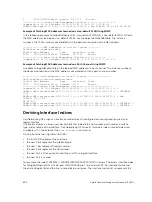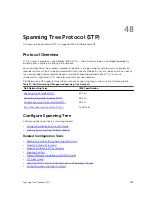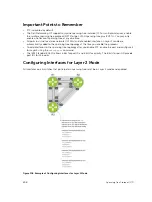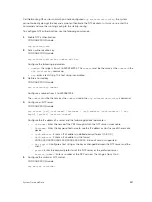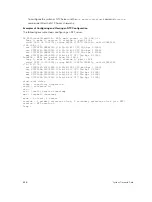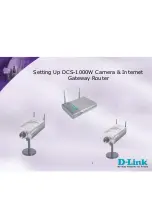
CAUTION: Enable PortFast only on links connecting to an end station. PortFast can cause loops if
it is enabled on an interface connected to a network.
To enable PortFast on an interface, use the following command.
• Enable PortFast on an interface.
INTERFACE mode
spanning-tree
stp-id
portfast [bpduguard | [shutdown-on-violation]]
Example of Verifying PortFast is Enabled on an Interface
To verify that PortFast is enabled on a port, use the
show spanning-tree
command from EXEC
Privilege mode or the
show config
command from INTERFACE mode. Dell Networking recommends
using the
show config
command.
Dell#(conf-if-te-1/1)#show conf
!
interface TenGigabitEthernet 1/1
no ip address
switchport
spanning-tree 0 portfast
no shutdown
Dell#(conf-if-te-1/1)#
Prevent Network Disruptions with BPDU Guard
Configure the Portfast (and Edgeport, in the case of RSTP, PVST+, and MSTP) feature on ports that
connect to end stations. End stations do not generate BPDUs, so ports configured with Portfast/ Edgport
(edgeports) do not expect to receive BDPUs.
If an edgeport does receive a BPDU, it likely means that it is connected to another part of the network,
which can negatively affect the STP topology. The BPDU Guard feature blocks an edgeport after
receiving a BPDU to prevent network disruptions, and Dell Networking OS displays the following
message.
3w3d0h: %RPM0-P:RP2 %SPANMGR-5-BPDU_GUARD_RX_ERROR: Received Spanning Tree BPDU
on
BPDU guard port. Disable TenGigabitEthernet 3/4.
Enable BPDU Guard using the
bpduguard
option when enabling PortFast or EdgePort. The
bpduguard
shutdown-on-violation
option causes the interface hardware to be shut down when it receives a
BPDU. Otherwise, although the interface is placed in an Error Disabled state when receiving the BPDU,
the physical interface remains up and spanning-tree will only drop packets after a BPDU violation.
The following example shows a scenario in which an edgeport might unintentionally receive a BPDU. The
port on the Dell Networking system is configured with Portfast. If the switch is connected to the hub, the
BPDUs that the switch generates might trigger an undesirable topology change. If you enable BPDU
Guard, when the edge port receives the BPDU, the BPDU is dropped, the port is blocked, and a console
message is generated.
NOTE: Unless you enable the
shutdown-on-violation
option, spanning-tree only drops packets
after a BPDU violation; the physical interface remains up.
Dell Networking OS Behavior
: Regarding
bpduguard shutdown-on-violation
behavior:
• If the interface to be shut down is a port channel, all the member ports are disabled in the hardware.
814
Spanning Tree Protocol (STP)
Summary of Contents for Z9000
Page 1: ...Dell Configuration Guide for the Z9000 System 9 7 0 0 ...
Page 80: ...grub reboot 80 Management ...
Page 128: ... 0 Te 1 1 Te 1 2 rx Flow N A N A 128 Access Control Lists ACLs ...
Page 491: ...Figure 70 Configuring OSPF and BGP for MSDP Multicast Source Discovery Protocol MSDP 491 ...
Page 496: ...Figure 73 MSDP Default Peer Scenario 1 496 Multicast Source Discovery Protocol MSDP ...
Page 497: ...Figure 74 MSDP Default Peer Scenario 2 Multicast Source Discovery Protocol MSDP 497 ...
Page 498: ...Figure 75 MSDP Default Peer Scenario 3 498 Multicast Source Discovery Protocol MSDP ...
Page 760: ...Figure 100 Single and Double Tag TPID Match 760 Service Provider Bridging ...
Page 761: ...Figure 101 Single and Double Tag First byte TPID Match Service Provider Bridging 761 ...



